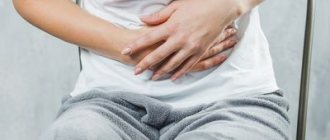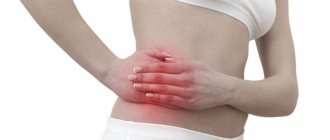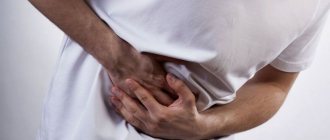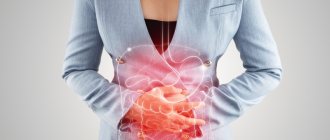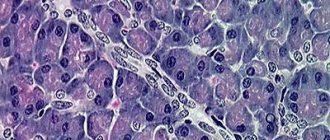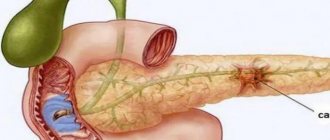Clinical picture of the disease
Exacerbation of pancreatitis occurs due to exposure to a provoking factor. First of all, this is the intake of alcohol, which causes a slowdown in the outflow of pancreatic juice, which is accompanied by a corresponding clinical picture.
The second common reason for the development of acute symptoms is non-compliance with proper nutrition, namely, abuse of fatty and fried foods, foods with trans fats and insufficient inclusion of protein-containing foods in the diet.
Other causes of exacerbation of pancreatitis include injury to the organ, blockage of the bile ducts by stone-like neoplasms, therapy with certain medications (antibacterials, glucocorticoids, immunosuppressants).
Symptoms that occur in the acute stage
The main symptom of acute pancreatitis is pain, which has unclear localization. In other words, a person cannot say exactly where it hurts. An exacerbation of the disease can be suspected based on accompanying symptoms.
The clinical picture arises not only from the diseased pancreas. The functioning of the intestines and stomach is disrupted, the general condition and ability to work change. Heartburn occurs, especially if the exacerbation occurs due to failure to maintain proper nutrition.
An attack of pancreatitis is also manifested by other symptoms:
- the presence of a bitter taste in the mouth;
- nausea and vomiting syndrome, diarrhea;
- decreased interest in food and, as a result, weight loss;
- yellowing of the skin and mucous membranes;
- increased dryness of the oral mucous membranes;
- decreased blood pressure and increased general temperature;
- weakness, chills.
The stool contains fragments of incompletely digested food.
Medicines for exacerbations
Therapeutic and supportive measures should be started immediately after the first symptoms of the acute process appear. If the pain is severe, you need to call an ambulance or take the person with the attack to the hospital yourself.
For moderate pain, treatment can be carried out at home, but only if the person is under the supervision of a doctor and knows what medications can be taken in case of exacerbation of pancreatitis. Therefore, the appropriate tablets should always be in the first aid kit. Treatment of symptoms of an attack of pancreatitis is primarily aimed at relieving pain symptoms and eliminating irritation of the mucous membranes of the gland. First aid measures:
- taking an analgesic or antispasmodic drug prescribed by your doctor, or giving an intramuscular injection;
- applying a cold compress to the area with pain (this can be a heating pad containing crushed ice, any product from the freezer, wrapped in cloth to prevent frostbite of the skin);
- maintaining shallow breathing with short delays (this helps reduce pain symptoms);
- elimination of suppression of vomiting, which alleviates the general condition.
It is important to maintain bed rest for several days, adjust your diet and drinking regimen.
From the group of analgesics and antispasmodics
Such products should be present in the home medicine cabinet of every patient with pancreatitis, including in chronic form. This will avoid the need to call an ambulance by quickly relieving pain with medications that are at hand.
The tasks of antispasmodics are to dilate the blood vessels of the organ, relieve spasms of the smooth muscles of the bile ducts and the sphincter of Oddi. The latter causes a failure in the outflow of pancreatic juice and bile fluid into the cavity of the duodenum.
The maximum duration of treatment with antispasmodics is no more than 2 days, since such drugs can cause serious adverse reactions.
Due to the fact that the pain syndrome associated with the disease is often long-lasting and acute, it is better to use drugs from the analgesic group in the form of a solution for intravenous injections
Injectables act much faster than their tablet counterparts. Severe pain is relieved with blockades of analgesic drugs, which are no less effective than injections.
From the group of anti-inflammatory drugs and enzymes
Since the pain syndrome is directly related to the exacerbation of the inflammatory process, drugs are prescribed that help suppress the corresponding reaction.
Inflammation can develop not only in the pancreas itself, but also spread to nearby organs (stomach and others).
To suppress inflammation, you need to take non-steroidal anti-inflammatory drugs or broad-spectrum antibiotics. These together reduce the risk of developing negative consequences, including:
- blood poisoning;
- peritonitis;
- abscess;
- pancreatic necrosis (inflammatory-necrotic process in organ cells).
Drugs from the group of enzymes that compensate for the production of enzymes in the gland also help prevent complications. These are prescribed after the acute phase has stopped. Pancreatin-based products are used more often. Preparations with bile acids help increase the production of pancreatic juice, so they are rarely used.
From the group of antisecretory agents
Drugs are prescribed to reduce the volume of enzymes produced by the pancreas and stop the progression of necrotic changes that can develop during self-digestion.
Antisecretory medications are prescribed at any stage, including during exacerbation of symptoms, to reduce the intensity of pain at an early stage of the disease.
The mechanism of action of antisecretory medications is associated with suppression of the synthesis of hydrochloric acid in the gastric environment, blocking histamine H2 receptors.
Antisecretory drugs are also prescribed for the reason that in 20-25% of cases pancreatitis occurs with ulcerative lesions, the changes characteristic of which extend to the head and body of the pancreas.
As a result, the motor function of the duodenum is impaired, duodenal hypertension develops, and duodenal-pancreatic reflux is formed. Due to such changes, control of acid production in the stomach is required, which helps smooth out clinical manifestations.
Which means are the most effective?
Popular drugs used for pancreatitis can be placed in the table:
| Group of drugs | Representative | Contraindications |
| Analgesics | Paracetamol | Hypersensitivity, severe impairment of liver and kidney function, children under 3 years of age |
| Baralgin | Hypersensitivity, severe kidney disease, liver disease, bronchial asthma, bronchospasm, blood pathologies, pregnancy in the 1st and 3rd trimesters | |
| Antispasmodics | No-shpa | Hypersensitivity, cardiac, renal or liver failure, children under 6 years of age |
| Papaverine | Hypersensitivity, renal failure, elderly and children under 6 years of age | |
| Anti-inflammatory | Diclofenac | Hypersensitivity, impaired hematopoietic function, gastric and duodenal ulcers, exacerbation of intestinal disease, children under 6 years of age, pregnancy in the 3rd trimester |
| Ibuprofen | Hypersensitivity, exacerbation of gastrointestinal disease, bleeding disorders, renal and liver failure, children under 6 years of age for effervescent tablets and up to 12 years for regular tablets, capsules, granules | |
| Antisecretory | Kvamatel | Hypersensitivity, pregnancy and lactation, children and adolescents under 18 years of age, liver and kidney failure |
| Omeprazole | Hypersensitivity, pregnancy and lactation | |
| Enzymes | Mezim | Hypersensitivity, exacerbation of pancreatitis |
| Festal | Hypersensitivity, exacerbation of pancreatitis, liver failure and coma, hepatitis |
Attack of acute pancreatitis: symptoms and first aid
06.11.2021
An attack of pancreatitis is caused by acute disturbances in the functioning of the pancreas , which produces enzymes for processing food. With pathological changes in the condition of the gland caused by the consumption of low-quality products, toxins, alcohol, enzymes begin to “eat” the tissue of the gland itself, thereby contributing to its destruction. This is where an attack occurs, which is triggered by the contents of the pancreas entering the abdominal cavity. A person with such a clinical picture must be urgently hospitalized to provide emergency care and relieve pain shock.
What factors cause an attack of acute pancreatitis?
The main function of the pancreas is its ability to take a direct part in digestion and help regulate metabolic processes. Its enzymes entering the duodenum help the intestines digest fats, proteins, and carbohydrates that a person consumes with food. As a result of an attack of pancreatitis , a pathological blockage of the common duct occurs, and all of the above substances remain in the gland itself, beginning to destroy it. There could be many reasons for it. Among the most common are the consequences of poor nutrition, sedentary lifestyle, overeating and constant stress.
Very often, the cause of an attack is a stone that has come out of the gallbladder and blocked the common duct. Another group of causes that cause pancreatitis is based on the structure of the pancreas . This is a muscle spasm that occurs in the sphincter of Oddi. With the help of this organ, enzymes are released into the duodenum. During the spasm that occurs, they return back to the gland. In this case, irreversible processes of destruction of the organ’s own body are launched. The products of such processes enter the intestines as a result of perforation. The person experiences unbearable pain.
The tissues of the main duct can be modified under the influence of toxins consumed systematically by humans. Scars appear on the inside of the duct. They become an obstacle to the enzymes. As a result of such cicatricial narrowings, the volume of juice destroys the parenchyma of the gland, which poses a great threat to human life.
How does an attack of acute pancreatitis manifest?
A patient with this pathology cannot move independently. This is due to severe pain piercing the upper abdomen , radiating to the shoulder blade, spreading along the left collarbone and back .
Pain has various manifestations. These include:
- spasmodic attacks
- burning and sharp tingling sensations
- boring and aching spills
A patient with an attack of pancreatitis is in a static position lying on his left side with his knees his stomach . The use of any means to relieve pain shock does not give any results. This is the main symptom of the disease. The attack may be accompanied by vomiting. Vomit has a green tint with admixtures of blood , mucus and bile. This condition may last for several days. Diarrhea is observed . Feces have a very unpleasant odor and are difficult to wash off. This indicates a high content of undigested fat in their composition.
The general picture of the disease resembles collapse. The person has cold extremities and is sweating. The skin has a bluish tint. Shortness of breath appears, the pulse is practically not audible. Body temperature rises to 38 degrees. Red dots resembling small bruises appear on the abdominal wall and chest Such symptoms may appear when a person does not expect them at all. But most often, an attack of pancreatitis can be triggered by eating too fatty foods and drinking alcoholic beverages in large quantities.
How to provide first aid during an attack of pancreatitis?
The patient's condition manifests itself in the presence of severe pain. It is necessary to try to remove it as quickly as possible in order to give the person with a major attack some rest and recovery. To do this, any antispasmodics available to the emergency medical technician must be immediately administered to the patient. to the abdominal . It can be ice wrapped in regular cloth.
In a hospital , treatment continues. For this purpose, drugs are used that relieve pain and relieve spasm of blood vessels . Drugs containing enzymes administered to the patient will help reduce its secretory function in the period after attacks and help improve digestion. Gastroenterologists also prescribe drugs that normalize the secretory activity of the pancreas . They are called prokinetic.
On the first day of such treatment, it is strictly forbidden to eat food. But droppers with a large amount of saline will help quickly flush destructive substances from the body. diet is prescribed for treatment , which the patient must follow for a long time. After all, pancreatitis is a disease that requires careful attention to your lifestyle, not only during periods of exacerbation. This disease can be prevented by carefully monitoring your weight and daily menu. After all, forms of pancreatitis , if treated incorrectly, can cause the development of a more serious disease - diabetes mellitus .
Published in Gastroentorology Premium Clinic
Nutrition in the acute phase
In addition to knowing how to relieve an attack of pancreatitis at home, you need to learn some nutritional rules. By following a certain diet, you can smooth out the clinical manifestations of acute pancreatitis and reduce the frequency and duration of exacerbation phases.
Principles of proper nutrition during illness:
- exclusion of foods containing fats, carbohydrates (especially sugar and foods containing it);
- increasing the volume of products with lean proteins;
- exclusion of fried, fatty, coarse fiber;
- maintaining fractional meals (small portions, but often throughout the day).
For pancreatitis, it is important to consume many vitamins and beneficial micro- and macroelements, and since it is difficult to get them all from food, doctors recommend taking synthetic drugs.
In the acute stage of pancreatitis, foods (except those prohibited) must be crushed before consumption, boiled or steamed. Frying is prohibited.
Diet in the first and subsequent days
During the first two days of exacerbation of the disease, a person is prohibited from eating. It is only permissible to drink mineral water (not carbonated). This helps to suppress the secretion of pancreatic juice, reduce the intensity of pain, and remove toxic substances and breakdown products from the body. Mineral water can be replaced with rosehip decoction.
On the third day, the diet can be diversified by including ground food. The following foods should not be included in the diet:
- salt-containing;
- fats and carbohydrates;
- coarse fiber;
- hot seasonings, smoked meats, spices;
- marinades, onions, garlic;
- baking;
- alcohol.
After reducing the intensity of inflammatory manifestations, you can eat puree soup, lean meats, fish, cottage cheese, cereals and vegetables (in addition to cabbage, which increases gas formation). You can drink fruit and vegetable juice, fermented milk products (yogurt, kefir, etc.).
How long the diet will last depends on the characteristics of the development of the disease. The average duration is 6-12 months.
The clinical manifestations of chronic pancreatitis (CP) are very variable, they are different during the period of remission and exacerbation of the disease, depending on the clinical form of the course, the stage of CP and a number of other factors. The dominant symptom of CP, especially at the onset of the disease and during the first years after diagnosis, is pain. Pain syndrome occurs among the majority of patients with CP and is considered the most striking manifestation of the disease. Only 15% of patients with CP have no pain, which is partly observed against the background of a progressive decline in the exocrine function of the pancreas (PG) [7].
Pathophysiology of pain in CP
The origin of pain in patients with CP has not been fully established and is most likely due to the combined effects of a number of factors, including obstruction of the pancreatic ducts with the development of pancreatic hypertension with persistent secretion of pancreatic enzymes, inflammation in the pancreatic parenchyma, especially perineural, and ischemia of the exocrine parenchyma. In addition, the formation of pain can be influenced by complications of CP - pseudocysts, duodenal and biliary hypertension, as well as secondary disorders of intestinal motility due to a progressive deficiency of pancreatic enzymes. Since the clinical course, range of complications, features of the clinical picture and prognosis vary depending on the etiology of the process, it is possible that the causes of the disease leave their mark on the formation of pancreatic pain and its features.
“Hydraulic” hypothesis of pancreatic pain: pros and cons
The hypothesis that has been dominant for many decades about pancreatic hypertension as the main cause of pancreatic pain [29, 40] has not yet found its objective confirmation due to a lot of contradictions. Indeed, in an experiment with patients with external pancreatic fistulas, the introduction of fluid (an isotonic solution of sodium chloride or a contrast agent) through them into the pancreatic ducts immediately causes typical pain, which disappears after evacuation of the injected fluid [3]. In support of this hypothesis, we can cite the results of endoscopic studies indicating a decrease or complete disappearance of pain after papillosphincterotomy, lithotripsy, lithoextraction of stones, stenting of the main pancreatic duct (MPD), at least for some period of time and with variable effectiveness [20, 43 ]. As is known, patients with dilatation of the gastrointestinal tract who respond to pancreatic testing with pain relief have better results after drainage surgical interventions [43], which indicates the validity of the hydraulic theory, at least for some patients. No less interesting is that improvement of drainage of pancreatic secretions in patients with CP and pancreas divisum (divided pancreas) by stenting the dorsal duct, even in the absence of severe hypertension and virsungolithiasis, was accompanied by a significant reduction in pain [13]. This observation can also be interpreted in favor of a hydraulic mechanism of pancreatic pain.
Of course, the presence of a similar mechanism for the occurrence of pain explains their intensification after eating and other stimulants of pancreatic secretion, which increase the pressure in the ductal system, partially or completely blocked due to scarring and inflammatory strictures and calculi. The recognition of this mechanism is the basis for the use of antisecretory and antispasmodic agents, as well as drainage operations in the treatment of CP [5].
At the same time, pancreatic hypertension and virsungolithiasis are observed in no more than 30% of patients with CP and abdominal pain syndrome (APS) [33]. In addition, dilatation of the pancreatic head can occur in pancreatic head cancer in the absence of typical pancreatic pain [7], and severe painful episodes resembling an attack of pancreatitis may be a consequence of dysfunction of the sphincter of Oddi of the pancreatic type, accompanied by moderate short-term hyperamylasemia in the absence of damage to the pancreatic parenchyma and risk development of CP [26]. In one of the first prospective studies with a long period of observation of patients with alcoholic CP (with alcoholic etiology, stones are known to be much more common), ductal stones developed in only 90% of patients with ALS during their lifetime [9]. The presence of ductal stones significantly increases the risk (odds ratio [OR] – 3.83; 95% confidence interval [CI] – 1.37–8.06) of persistent pain, but does not guarantee it [30]. The high frequency of repeated endoscopic interventions in patients with CP and proven pancreatic hypertension (more than 3 endoscopic procedures in an average of 3.4 years - papillotomy, lithotripsy and lithoextraction) [17] indicates the inadequacy of control of pancreatic hypertension alone to prevent pancreatic pain, which indirectly indicates in favor of the existence of alternative mechanisms. In endoscopic studies aimed at pancreatic decompression, a long-term effect of pain relief is observed in only 2/3 of patients, while patients with a short history of pain respond best to endoscopic manipulations [20], which also allows us to speculate about the addition of other development mechanisms to ductal obstruction BASS.
"Inflammatory" theory
Thus, a number of contradictions in the hydraulic theory of pancreatic pain led to the generation of new ideas, in particular about the significance of inflammation in pancreatic tissue, which were confirmed by experimental studies. Even if you pay attention to the definition of CP, reflected in a number of recent recommendations, it turns out that this is an inflammatory (and not obstructive) disease [2, 25, 14], although in the latest Spanish recommendations, the authors are more careful with the definition of CP, talking about damage [ 32].
So, it is assumed that inflammatory infiltration of the pancreatic parenchyma and subsequent progressive fibrosis, especially in the areas of sensory nerves, lead to their compression and the development of neuropathy, increasing the tropism of pancreatic sensory nerves to the influence of various exogenous influences (alcohol, drugs and other factors) [5 , 18, 47]. This concept is supported by the now canonical study of H. Friess et al. (2002), who showed an almost twofold increase in the number of nerves in the pancreas parenchyma and an order of magnitude increase in the area of nervous tissue in the pancreas in patients with alcoholic CP relative to the norm [24], which may underlie persistent neuropathic pain. Chronic inflammation in the pancreas as a source of many mediators is also considered as the cause of the formation of visceral hypersensitivity as a mechanism (or its component) for the development of pancreatic pain [34, 36].
Currently, the central mechanisms of pain in patients with CP, initiated by inflammation as a trigger mechanism, are also being discussed [22, 27, 37]. At the same time, it is not entirely clear why in autoimmune pancreatitis, characterized by severe inflammatory infiltration of the parenchyma and ducts, including their irregular narrowing, ALS is not the leading syndrome and occurs only among 50% of patients [6, 21, 39] . Apparently, the influence of etiology (alcohol, genetics, autoimmune mechanisms) and the duration of the process on the formation of heterogeneous inflammatory changes is affected.
Concept about two types of pain
These contradictions, which have existed for a long time and are very superficially discussed above, as well as the experience of long-term prospective observation of patients with CP formed the basis for the creation of the concept of two types of pancreatic pain - types A and B [10]:
- type A: short attacks of pain with a duration of less than 10 days against the background of long pain-free periods (more frequent in idiopathic senile CP or late-onset CP);
- type B – pain is prolonged or constant (more severe and prolonged episodes with pain-free periods lasting 1–2 months, more often with alcoholic and idiopathic juvenile CP or with early-onset CP).
It can be assumed that in the first case, the genesis of ALS in CP is caused primarily by inflammation, resembling the pain in acute pancreatitis, but more often it is less pronounced, periodically recurs and is characterized by pain-free periods of varying duration. ALS is more severe during the first 6 years from the onset of the disease; over time, the severity of pain decreases; after 10 years, less than 50% of patients are characterized by the presence of pain [10]. Indeed, according to G. Cavallini et al., after 15 years from the moment of diagnosis, only 25% of patients with CP continue to suffer from recurrent ALS, but the frequency of attacks of pancreatitis on average, as a rule, does not exceed 1 episode of exacerbation per year [16]. The second mechanism of ALS according to RW Ammann and B. Muellhaupt is due to a more severe course of pancreatitis with pancreatic hypertension, calcification, persistent inflammation, local complications, in particular the formation of pseudocysts, which, at a certain location and size, can exert compression on the duodenum, Wirsung duct, biliary tract and other organs [10, 11].
This division of pain types is today recognized by most experts, since it influences the choice of treatment tactics - conservative or surgical [1]. Taking into account the numerous contradictions in ideas about the pathophysiology of pancreatic pain, one can assume that this division is imperfect, especially since almost 15 years have passed since the publication of the basic publication [10], during which many interesting facts, observations and hypotheses have appeared. First of all, this concerns type B pain, the main symptom of which continues to be more justified surgical treatment tactics. In this case, the choice of surgical treatment is based on the presence or absence of GLP dilatation. In other words, usually in case of dilatation of the gastrointestinal tract, palliative endoscopic or radical surgical drainage or combined interventions are performed; in its absence, resection techniques up to pancreatectomy are performed [4]. This logic raises a number of questions, for example: how legitimate is it to perform pancreatectomy in a patient with CP without duct dilatation and with the presence, say, of central pain mechanisms, when a course of treatment with tricyclic antidepressants can be just as effective (and significantly less invasive), not to mention postoperative morbidity? ? In the draft Russian recommendations for the diagnosis and treatment of CP, a similar situation is conditionally provided for - a patient with CP should receive conservative treatment for up to 3 months; if there is no effect in pain relief, it is necessary to discuss the possibility of surgical treatment [2].
In our opinion, today we have enough reason to assume the presence of several mechanisms of pain in patients with CP, combined depending on the combination of etiological factors, the continuation of their influence, the duration of the disease, the preservation of the pancreatic parenchyma, and genetic predisposition (variability of the immune response). In this regard, the general practitioner faces many difficulties in relieving pancreatic pain. Due to the polyetiology of CP and the versatility of its pathogenesis, it is impossible to develop a pain relief algorithm that is universal for all forms and stages of the disease. That is why the leading pancreatological associations of the world today offer the practicing physician basic principles for the management of such patients, based on evidence-based data, the translation of which through the prism of their own experience will allow the doctor to provide effective treatment with a personalized approach.
Principles of pancreatic pain relief
So, what should a practicing physician do when the situation with understanding pancreatic pain still remains so confusing and contradictory?
In our opinion, patient management tactics should be based on the following fundamental postulates [2, 4, 5, 7]:
- Regardless of the type of pain, the most optimal approach is to determine the etiology of CP (the key to which remains a thorough examination), since the etiotropic effect is most effective and in some cases can be accompanied by resolution of pancreatitis.
- Patients should be advised to refrain from smoking and alcohol abuse (a likely pancreatotoxic dose is 50 ml of pure ethanol per day). Stopping alcohol intake reduces the frequency and severity of ALS in 75% of patients with alcoholic CP. Patients with painful forms of CP who continue to smoke respond worse to therapy aimed at pain correction, which also needs to be taken into account when selecting therapy.
- Taking into account the multifactorial nature of pain mechanisms, complex conservative treatment is proposed (groups of drugs for such therapy are presented below):
- non-narcotic analgesics are the drugs of choice for both types of pain, because in addition to symptomatic pain relief, they have an anti-inflammatory effect. Analgesics should be taken before meals to prevent postprandial worsening of pain. Their doses are selected individually, and the lowest effective dose should be used. In our opinion, the recommendations of a number of foreign associations about switching to narcotic analgesics when non-narcotic analgesics are insufficiently effective in real Russian reality are implementable only for a short period of time in a hospital, therefore for our patients the issue of developing drug addiction is less relevant;
- modern pancreatic enzymes prescribed for the correction of pancreatic insufficiency (minimicrospheres, microtablets), which makes it possible to eliminate maldigestion and associated pain components caused by increased intestinal motility. Tablet-free pancreatin preparations with a high content of proteases, which have shown in controlled studies the effect of reducing pancreatic pain according to the principle of negative feedback (Viokase, Cotazim), have not been registered in Russia;
- vitamin-mineral antioxidant complexes to reduce the severity of oxidative stress and indirect effect on pain;
- antisecretory agents, which, by suppressing gastric secretion, indirectly reduce pancreatic secretion, increasing the effectiveness of enzyme replacement therapy;
- tricyclic antidepressants used to potentiate the action of analgesics, cholinergic drugs, reduce visceral hypersensitivity, weaken intestinal motility;
- myotropic antispasmodics, among which the greatest interest is represented by relatively newer generations of drugs, characterized by a duration of effect, the possibility of long-term use, good tolerability, and the ability to influence different mechanisms of pain.
- If conservative measures are insufficiently effective within 3 months (or earlier, if the clinical situation requires it), the issue of surgical treatment should be decided.
Features of the treatment of type A pain
When ALS relapses in a patient with CP (type A pain), first of all, especially if it is atypical and there is no effect from standard therapy, it is necessary to evaluate “fresh” structural changes in the pancreas (inflammation, pseudocyst, papillitis, stricture or stone, space-occupying formation), which in general and will determine the further tactics of patient management - continuation and/or modification of pharmacotherapy, endoscopic or surgical treatment.
Patients with CP with type A pancreatic pain often use a synthetic long-acting somatostatin analogue, octreotide, in routine practice. In a number of studies, this drug has shown a good inhibitory effect on the expression of cholecystokinin, basal and nerve-stimulated pancreatic secretion. Unfortunately, large-scale controlled trials evaluating the effect of octreotide in painful forms of CP have not yet been conducted. Short 3-day studies administering 100 and 150 mcg of octreotide three times daily had no effect on pain relief in patients with CP [31]. In a randomized, multicenter, 4-week placebo-controlled study, octreotide was used in doses of 40–200 mg 3 times daily to evaluate its effectiveness in CP with severe ALS. Although no statistically significant results were obtained in this study, octreotide at a daily dose of 600 mg was the most effective for pain relief (65 vs. 35% in the placebo group). In addition, it was noted that octreotide was more effective for patients with persistent ALS than for patients characterized by intermittent pain [42]. The prospects for long-term studies assessing the effect of octreotide on pancreatic pain are limited by a significant increase in the side effects of the drug with long-term use. It is known that with prolonged treatment with octreotide, maldigestion is aggravated due to a sharp decrease in the flow of pancreatic enzymes into the duodenum; intestinal paresis, deterioration of blood supply to the pancreas, and hypotension of the gallbladder with cholecystolithiasis are possible [5]. These facts are clearly seen in the prospective North American NAPS2 study, which showed a low frequency of octreotide prescription for pain relief compared to other conservative measures (7%) with an effectiveness of less than 50% [15].
For patients with pancreatic pain type A, along with analgesics, antispasmodic therapy is often very effective, especially with the use of hyoscine butyl bromide (Buscopan®). The theoretical justification for the use of antispasmodics in CP is an attempt to reduce with their help the pressure in the gastrointestinal tract, common bile duct, and duodenum by leveling the spasm of smooth muscles, especially the sphincter of Oddi [7].
Interest in hyoscine butyl bromide is determined by a number of the following fundamental points:
The onset of effect is rapid (within 15 minutes) [44], which is extremely important from the point of view of theoretically reducing the risk of progression and severity of pancreatitis attack.
The proven ability of hyoscine butyl bromide to act on the sphincter of Oddi in experimental [19,41] and clinical studies using sphincter of Oddi manometry [8, 28, 45] facilitates the outflow of pancreatic secretions.
The optimal duration of action is within 3–6 hours [44].
In open clinical studies, patients noted the high effectiveness of the symptomatic use of hyoscine butyl bromide for abdominal pain - 87%, while it was noted that the absence or insufficient effect occurs only in the case of late administration of the drug - on the third day from the onset of pain manifestation [36], which requires its immediate use at the first signs of a HP attack.
The presence of hyoscine butyl bromide has an antisecretory (cholinergic) effect that can reduce gastric and pancreatic secretion [44], thereby providing an additional beneficial effect.
Features of the treatment of type B pain
For patients with CP with persistent ALS, it is advisable to begin treatment with a combination of a non-narcotic analgesic (paracetamol 500–1000 mg 3–4 times a day) with vitamin-mineral antioxidant complexes (tocopherol, ascorbic acid, carotene, zinc, selenium, copper, methionine) [2,12] , which will provide not only analgesic, but also anti-inflammatory effects, including by reducing oxidative stress. If there are signs of pancreatic insufficiency, it is necessary to prescribe enzyme replacement therapy with minimicrospheres or microtablets of pancreatin in daily doses of at least 100–150 thousand units of lipase, which can reduce the severity of pain by normalizing intestinal digestion and resolving intestinal motility disorders [2], which has been proven in controlled studies [38]. In order to potentiate the effect of analgesics, weaken the phenomenon of visceral hypersensitivity and level the central mechanisms of pain, it is appropriate to prescribe tricyclic antidepressants in low doses (for example, amitriptyline 30–50 mg/day).
Taking into account the significance of pancreatic hypertension for patients with CP with type B pain, one can expect an effect from antispasmodic drugs (hyoscine butyl bromide), the response of which to the sphincter of Oddi has been proven by studies using manometry [8, 28, 45]. It is interesting that the comparability in controlled studies of the analgesic effect of hyoscine butyl bromide with paracetamol [35], which is the analgesic of choice for the treatment of pancreatic pain, in the absence of hepatotoxic action of hyoscine butyl bromide, makes it possible to combine it with paracetamol in order to reduce the daily dose of the latter. An important advantage of hyoscine butyl bromide is the possibility of long-term safe use – 4–12 weeks (the range of side effects in controlled studies is comparable to that of placebo) [23, 44]. Just this time is enough to achieve relief or significant reduction of pain in a patient with CP and type B pain or to make a decision on the need for endoscopic or surgical treatment.
Conclusion
Relieving pancreatic pain is a difficult task, which, unfortunately, is not always amenable to conservative treatment methods. Taking into account the polyetiology of pancreatitis and the versatility of the pathophysiology of pain, most patients require combined or complex pharmacotherapy. Approaches to combinations of drugs, apparently, should be determined individually, based on etiology.
logy of pancreatitis, type of pain, stage of the disease and the presence of complications, based on the recommendations of national and international gastroenterological and pancreatological associations, the decisions of which are based only on evidence-based data.
Unconventional treatment
During the acute stage, treating pancreatitis with non-traditional methods is inappropriate due to their ineffectiveness. However, in the remission phase, they help reduce the intensity of the inflammatory process, thereby reducing the duration and frequency of exacerbations.
You should immediately take into account that folk remedies will have to be taken for a long time and on an ongoing basis. Medicinal herbs are used as a basis:
- pharmaceutical camomile:
- immortelle;
- thyme;
- yarrow;
- plantain;
- celandine.
Infusions and decoctions are made from herbs, which are taken orally instead of tea throughout the day. The following folk remedies will also be effective:
- drinking potato juice in its pure form (50 ml per day);
- preparing medicinal porridge: pour raw buckwheat with kefir, leave to infuse overnight, take in the morning instead of breakfast;
- use of oatmeal jelly: soak the flakes in water for half an hour, add water and boil for an hour until a thick consistency is obtained.
Despite the fact that alternative medicine products have a natural composition and do not contain synthetic components, even these can cause harm to the body if used incorrectly.
In addition to being accompanied by severe symptoms, attacks of pancreatitis can be complicated by negative consequences. Therefore, it is not enough to take painkillers. Treatment of the disease must be comprehensive.
